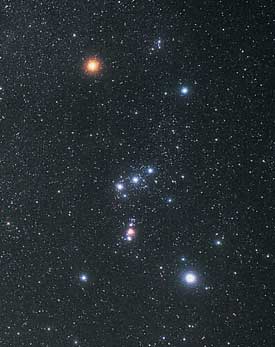
Orion, the Hunter, takes center stage in the sky throughout winter and early spring in the Northern Hemisphere. The Orion Nebula is clearly visible as a pink patch below the 3 stars of Orion's Belt.
Courtesy Akira Fujii.
From 1946 to 1994, Sky & Telescope magazine featured a column called Deep-Sky Wonders, written by amateur astronomer Walter Scott Houston. In it he explored the dim denizens of the deep sky — asterisms, double and variable stars, open and globular clusters, nebulae, and galaxies.
Deep-Sky Wonders, a month-by-month selection of those columns, was published in 1999 and is available from Sky Publishing. The following seasonal guide to a variety of nebulae consists of excerpts from the book.
The Beauty of Orion
The Orion Nebula (M42) has inspired more adjectives than any other nebulae. None, however, do real justice to this great mass of swirling, pale green, chaotic gas. Even “overpowering” is a most inadequate word when the nebula is seen in a really dark sky. Intertwined with the Sword on the Hunter’s Belt, M42 requires no charts or setting circles (see the photograph on the previous page). There’s no need for a finder, either, since you can simply sight along the edge of the telescope tube to bring the nebula into view. (For more on the Orion Nebula see the article "A Pair of Nice Nebulae.")
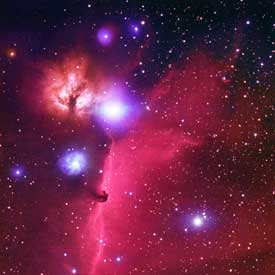
The Horsehead Nebula is a challenging visual target for small-scope observers, although the bright streamer IC 434 is easier to see. The nebula NGC 2024 is to the left of the bright star Zeta Orionis (located directly above the horse's head). North is up.
Courtesy Robert Gendler.
The Horsehead Nebula (Barnard 33) is one of the most photographed but least observed nebulae in the sky. It’s incredibly challenging for visual observers. The blob of darkness lies halfway along the streamer of faint nebulosity that runs for 1° south from Zeta (ζ) Orionis, the easternmost belt star.The streamer IC434) is a bit brighter than the Veil Nebula in Cygnus, and no great feat to see.
But recognizing the dark blotch B33 is another matter. Scattered light from 2nd-magnitude Zeta foils many attempts to find the Horsehead, since the two are separated by only ½°. Another reason that many searches fail is that observers are looking for the wrong-sized object. When I have seen it with telescopes between 10 and 16 inches in aperture, my first reaction has always been how tiny it is! Knowing just where to look for it is half the battle. The Horsehead is only 5' across. Amateurs accustomed to seeing it on large-scale photographs end up looking for an object that is much too big.
The Crab Nebula and Other Winter Treats
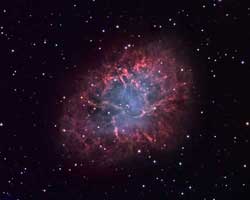
The Crab Nebula (M1) is located about 1° north and a little west of Zeta Taurus, a bright star that marks the tip of one of the horns of Taurus, the Bull. North is up.
Courtesy Robert Gendler.
The Crab Nebula (M1) can be seen in 2-inch finders. Small telescopes reveal only a shapeless 8th-magnitude blur variously sketched as oval, rectangular, or more often something in between. The Crab usually shows in small telescopes as a featureless gray ghost. My 4-inch Clark refractor has revealed hints of the nebula's ragged edge that appears so prominently in photographs. These edge serrations are usually apparent in a 12-inch telescope and easy in a 17-inch. Increased magnification does not seem to change the appearance much. Telescopes of 12-inch aperture and larger often reveal delicate filamentary structure in the nebula.
One object that everyone should enjoy is M76, an unusual planetary nebula on the edge of a dense part of the Milky Way. Often called the Little Dumbbell because it resembles the more-familiar Dumbbell Nebula (M27), to me it always looks more like a dog biscuit. The nebula has a reputation of being hard to find, so here's how best to find it. Start with Phi (φ) Persei. This star and a dimmer one just to the south form a pointer, with Phi at the head, that directs the observer to a diamond of faint stars, within which M76 is dimly perceptible.
With a small aperture or in indifferent sky conditions, M76 shows only a dim irregular oval with ragged edges. But one night, with an 8-inch reflector in the hills north of the Golden Gate in San Francisco, M76 was a most exciting object. High magnifications brought out an intricate network of turbulent celestial clouds.
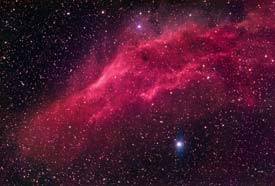
The California Nebula in Perseus is fainter but almost as large as the North American Nebula. The bright star below NGC 1499 is Xi Persei. North is up.
Courtesy Robert Gendler.
The California Nebula (NGC 1499) is a vast cloud of glowing hydrogen about 2½° long and ¾° wide. It's known as the California Nebula because its shape, recorded on long-exposure photographs, is similar to that of the western state. Conventional wisdom has long held that the surface brightness of NGC 1499 is too low to be seen against the background sky visually in any telescope. Today the term low surface brightness (LSB) is used to describe large, diffuse objects such as the California Nebula. Their surface brightnesses are so close to that of the sky background that the observer can run his or her eye across the edge of the object without realizing the view has changed from sky to nebulosity. These objects are seen only when the sky is dark and transparent. A low magnification should be used so that the field of view shows plenty of sky to contrast with the object.
A Spring Rosette and the Ghost of Jupiter
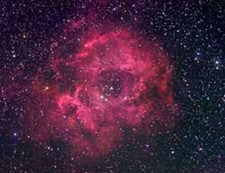
Situated in Monoceros (nearly half-way between Betelgeuse and Procyon), the Rosette is an emission nebula. Embedded in the southeastern portion of the nebula is the open star cluster NGC 2244. North is up.
Courtesy Robert Gendler.
An old favorite of mine is the Rosette Nebula (NGC 2237–39) to the east of Orion in the stellar wilderness we call Monoceros. Without a filter only a tiny glimmer of light is visible, but with an ultrahigh-contrast (UHC) filter the nebula bursts forth in spectacular fashion. I know of no other object in the sky where flicking a filter back and forth in front of a naked eye produces such a wonderful effect. Indeed, about 1983 both Brian Skiff at Flagstaff, Arizona, and I independently viewed the Rosette with the naked eye and a nebula filter.
The Rosette is one of the few deep-sky objects better seen with a telescope's finder than with the main instrument. With large binoculars and good observing conditions, the Rosette may appear as a formless aura of soft light encircling a cluster. But equipped with a proper filter, just about any telescope will show it.
There is a fine planetary nebula in Hydra, NGC 3242. It is located about 2° south and slightly west of the 4th-magnitude star Mu (μ) Hydrae. It's sometimes called the Ghost of Jupiter because it's similar in size and color to the planet Jupiter. The total light of NGC 3242 roughly equals that of an 8th-magnitude star. With a disk only 0.5' in diameter, the surface brightness of this planetary is quite high, averaging about 10 times greater than the Ring Nebula in Lyra. I looked at it with my 5-inch Apogee telescope and a 20x eyepiece. It appeared slightly oval but without the pointed ends so prominent in photographs of the object. I also examined NGC 3242 with a Lumicon UHC nebula filter. The results were impressive.
Two Great Summer Planetaries
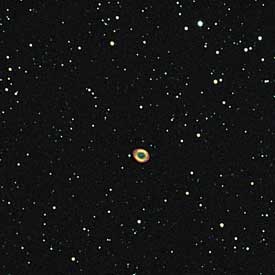
The Ring Nebula (M57) in Lyra appears as a tiny, dim gray doughnut of light through most small telescopes, but a time-exposure photograph such as this one reveals its true colors.
Courtesy Akira Fujii.
The Ring Nebula (M57) in Lyra is one of the best-known objects in the summer sky. The Ring differs from most planetaries by the almost perfect sharpness of its outlines, and the completeness of the ring form, in contrast to such objects as the Dumbbell Nebula (see below). Also designated NGC 6720, M57 is easily found halfway between Beta (β) and Gamma (γ) Lyrae. It's oval, 80" by 60", and is of the 9th magnitude visually.
I probably looked at the Ring Nebula with a greater variety of telescopes than I have at any other heavenly subject. One of my best views came with the 12-inch f/17 Porter turret telescope on Breezy Hill in Springfield, Vermont, the site of the annual Stellafane convention. At 200x the ring was bright, slightly elongated, and of uniform luminosity. An increase to 600x changed the picture dramatically. No longer was the smoke ring evenly bright. Instead, two sides of the ring were made up of curved and twisted streamers. The oval now had pointed ends, and the central region was full of turbulent detail.
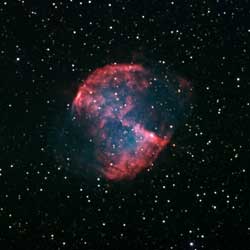
M27, the famous Dumbbell Nebula, was the first planetary nebula discovered. It's one of the brightest planetaries in the northern sky. North is up.
Courtesy Robert Gendler.
The August sky contains many delightful planetary nebulae — ephemeral spheres of blue and green gas that float amid the pearly star currents of the Milky Way. Certainly one of the most observed is the Dumbbell Nebula, M27, in Vulpecula. To find it, set your finder on Gamma (γ) Sagittae, the head of the celestial arrow. Sweep about 5° north and you should see an M-shaped pattern of stars composed of 12, 13, 14, 16, and 17 Vulpeculae; this group is more conspicuous to the eye than most star charts lead you to believe. M27 is just ½° south of the M's central star.
I don't believe many observers see the dumbbell shape without having a bad wrench to the imagination. With my 4-inch Clark refractor, a quick look reveals the planetary as two cones with their apexes in contact. After finding the best eyepiece for the evening's sky conditions, and by using averted vision, I usually see the faint nebulosity between the brighter parts of the cones. By gently rocking the telescope back and forth — which sets the planetary in motion and helps the eye capture the faintest extensions of light — I found the end result is a full circle of light, just as one would expect of a planetary. The luminosity of the interior varies greatly, but the circular outline remains firmly fixed. (For more about the Dumbbell Nebula, see "A Pair of Nice Nebulae.")
More Summer Sights
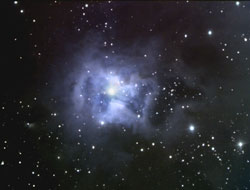
Binocular and small-telescope users will find the reflection nebula NGC 7023 to be an interesting sight.
Courtesy Robert Gendler.
NGC 7023 is an object that has been called one of the brightest reflection nebulae, an encouraging description to say the least. It's 3½° southeast of Beta (β) Cephei, centered on a 6th magnitude star that is easily seen in binoculars. From my earliest days as an observer I have notes that refer to the nebula as "real bright," and question why it is not plotted in Norton's Star Atlas. I suspect it is an easy object for binoculars.
Close to the southern edge of the Big Dipper's Bowl is the remarkable planetary nebula M97, popularly known as the Owl. M97 is no problem for 4-inch telescopes, and I have easily seen it in 15 x 65 binoculars. The two dark spots that form the Owl's "eyes" are more challenging, but under good skies they might be within range of a 4-inch telescope. The nebula measures only 3', and if it isn't seen at once, let your eye wander aimlessly over the field of view until the disk springs into view.
In Ophiuchus is the globular cluster M9. It's near the northeast edge of a remarkable dark nebula, Barnard 64, less than ½° west of it. With my 4-inch Clark refractor or 5-inch Apogee telescope the dark nebula is easily seen. Most dark nebulae are difficult to "see," but here the rich background is rather uniform, and it's interesting to compare the star densities northeast and southeast of M9. Try powers of about 100x. (To discover more dark nebulae, see the article "Seeking Summer's Dark Nebulae.")
Three Challenging Autumn Nebulae
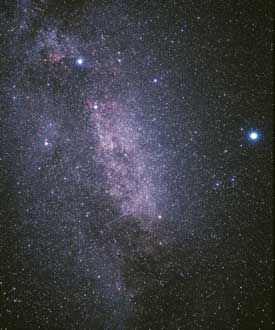
Thousands of stars crowd this image of the northern Milky Way. Deneb is the bright star to the upper left; Vega is on the right. North is to the upper right. NGC 7000 is to the left of Deneb. Click on the image to see the location of NGC 7000.
Courtesy Akira Fujii.
The North America Nebula (NGC 7000) is familiar from photographs as a large diffuse glow about 3° east and 1° south of Deneb. There has been remarkable diversity of opinion on how small a telescope can show this object visually. If observing conditions are very good, and you know what size and shape to expect, the North America Nebula can be made out easily with the naked eye. An opera glass makes it more apparent, but this is not true when more powerful binoculars are used.
Actually, NGC 7000 is difficult to see in most telescopes. With a 5-inch Moonwatch Apogee telescope you should know beforehand what it looks like, and the nebula is downright challenging in a 6-inch f/4. However, a few years ago it was brilliant when I saw it in an 11.4-inch Wright telescope.
The most famous celestial sights were passed down to us throughout the centuries. There are some objects which, in a sense, belong to the modern amateur. One such object is the Veil Nebula in Cygnus, a broken bubble of luminous gas some 2° in diameter. Although ignored by generations of telescope users, in the last 30 years the Veil has progressed from a difficult test object to a reasonable target for anything from binoculars to the largest amateur telescopes. It's an excellent nebula for training the eye, perhaps the most important observing "accessory," to help us get the most out of the telescope we're using.
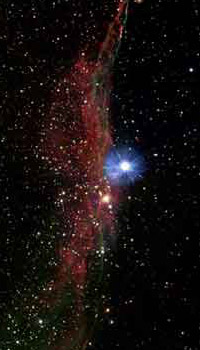
The Veil Nebula in the southern part of Cygnus can be a challenging target unless the skies are clear and dark. This is a view of NGC 6960, the western half of the nebula. North is up.
Courtesy Robert Gendler.
The western section bears the name NGC 6960. The 4th magnitude double star 52 Cygni appears to be involved with NGC 6960 but is actually a foreground object not related to the nebula. Even in small telescopes, 52 Cygni is an excellent double; its orange and blue components, magnitudes 4.5 and 9.5 are separated by 6½". The eastern loop of the Veil is NGC 6992–95. Like the western part, it's a strip of sculptured light about 1° long.
Both the east and west arms of this loop are easy in my 20 x 125 Japanese military binoculars. In a 12-inch f/5 telescope the Veil Nebula in Cygnus is beautiful, and so bright that one notes it even when sweeping. But in a 5-inch f/5 the Veil is visible only with difficulty to keen eyes.
The planetary nebula NGC 7293, also known as the Helix Nebula lies in Aquarius about a third of the way from Upsilon (υ) Aquarii to 47. It has a total magnitude of about 6, but its large apparent diameter — nearly half that of the Moon — spreads the light out and makes it a difficult object visually. I recently saw the Helix Nebula with the 4-inch Clark refractor and was certain that it was glimpsed in a 2-inch finder. Years ago I suggested that readers send me their observations of the Helix Nebula. The bulk of my correspondents indicated that the Helix was more readily seen in binoculars and finders than in telescopes.
 0
0








Comments
You must be logged in to post a comment.